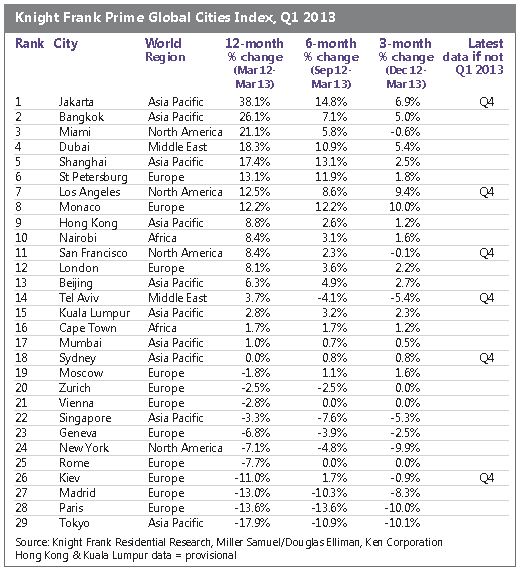Global Housing - Tokyo leads luxury residential market slowdown
The average price of luxury homes in the world’s key cities fell by 0.4% in the first quarter of 2013 although the annual rate remained positive at 3.6%. Kate Everett-Allen examines the latest index results:
- Prime property prices fell on average by 0.4% in the first quarter of 2013
- Prime prices across the 29 cities tracked by the index increased by 3.6% in the year to March 2013
- Cities in Europe remain the weakest performers, recording a fall of 2.3% on average
- Jakarta (up 38.1%) was the strongest performing prime residential market
- Tokyo (down 17.9%) was the weakest performing prime residential market in the last 12 months
Jakarta, Bangkok and Miami topped the table this quarter, recording annual price growth of 38.1%, 26.1% and 21.1% respectively.
The measures aimed at cooling residential price growth in Jakarta and Bangkok have been less stringent than those applied across many neighbouring Asian cities, allowing new middle class wealth to fuel demand and push prime prices higher. In Miami’s case, Latin American wealth is a key driver of the luxury market, with the flow of capital from Brazil, Venezuela and Argentina proving influential.
Cities in Asia, North America and the Middle East continue to dominate the top half of the results table while seven of the bottom ten rankings are occupied by European cities.
A typical prime property is now worth 21.3% more than it was in Q2 2009 when the Prime Global Cities Index hit its post-Lehman low.
Eight cities recorded double digit price growth in the year to March including stellar performances by the European cities of St Petersburg and Monaco. The price of luxury homes in Monaco increased by 10% in the first three months of 2013 as international interest swelled and the supply of apartments, particularly above €10m, proved limited.
Tokyo, recording a 17.9% fall in prime prices, was the weakest-performing city in the year to March 2012. However, after nearly 15 years of deflation, the Bank of Japan has announced radical monetary-easing measures, and as a result business sentiment as well as demand for prime property is now strengthening.
Unlike Japan, the governments of China, Hong Kong, Malaysia and Singapore face the opposite challenge; trying to restrain growth. As the latest edition of our Asia Pacific Residential Review explains, Asia’s policy makers are not only introducing more lending restrictions, taxes and regulations, but the strength of these measures has been stepped up in recent months.
The 9.9% decline in prime New York property prices in the first three months of 2013 is a reflection of the rush to complete sales in the final quarter of 2012 prior to the fiscal cliff which led to a markedly slower start to the year.
In each year since 2009, our Prime Global Cities Index, has repeatedly recorded its weakest rate of growth in the first quarter of the year. As a result, we expect stronger growth to emerge in the second quarter as buyers continue to search for luxury bricks and mortar as a way of sheltering their assets from the Eurozone’s continuing turmoil and the fragile global economy.

Courtesy: Knight Frank

For further information, please contact:
Bronya Heaver, International PR Manager, 020 7861 1412, [email protected]






